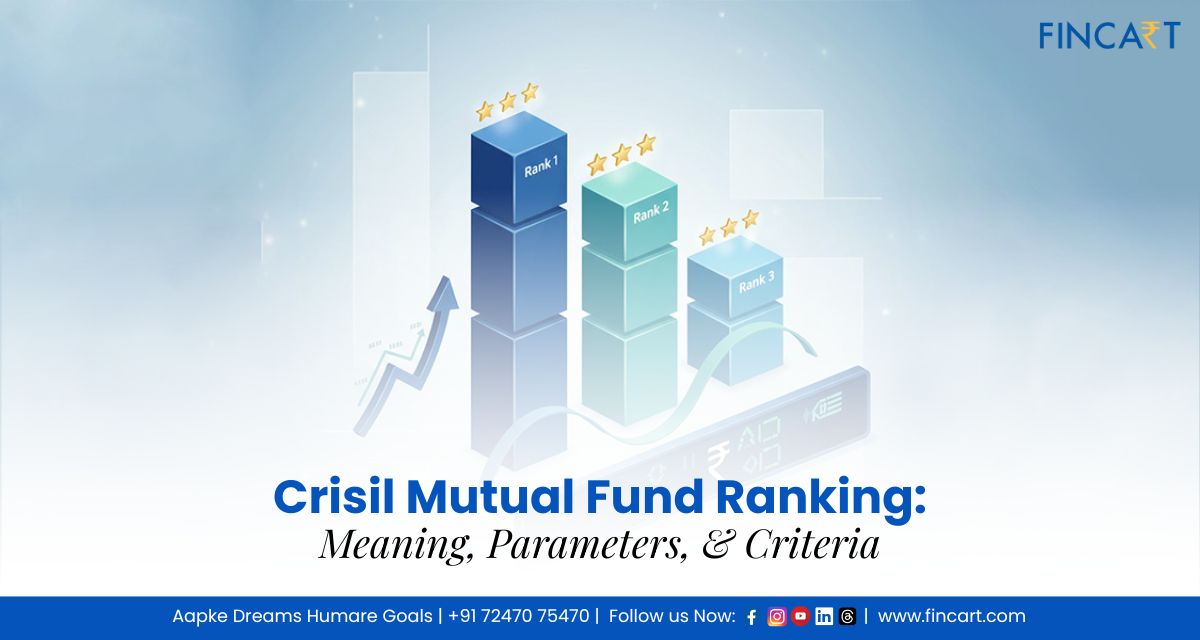Starting in 1987 as the Credit Rating Information Services of India Limited, the organisation became India’s first-ever credit rating agency. Over the years, Crisil has evolved into a financial analytics powerhouse, offering insights across credit ratings, risk analysis, and investment ratings. Essentially, its ratings, analyses, and rankings help investors make better financial decisions. One such investment research initiative is the crisil mutual fund ranking, which ranks mutual fund schemes based on a number of factors such as their risk-adjusted returns, portfolio concentration, and asset quality. Today, we’ll explore how the CMFR system works and how investors can use it to make well-informed investment decisions.
What is Crisil Mutual Fund Ranking?
If you’re planning to invest in a mutual fund, you’ve got to look beyond just the returns. Of course, past returns matter, but they don’t tell you the full story. There are a whole lot more factors that determine how a fund performs. Things like how much risk it takes to earn those returns, how diversified its portfolio is, how easily it can be liquidated, and so on. The crisil mutual fund ranking system basically combines all these quantitative performance factors to assign a rank to schemes from equity, debt, and hybrid fund categories.
Mutual fund schemes are given ranks only within their respective peer groups. This means a large-cap equity fund is compared only with other large-cap equity funds, and a debt fund against other debt funds. These rankings not only give investors an easy way to judge how well a fund performs, but are also widely acknowledged across the mutual fund industry. Many fund houses use these rankings, and chances are, you may even come across a Mutual fund advisor or a distributor who refers to Crisil rankings for evaluating performance.
How the Crisil Mutual Fund Ranking System Works
Crisil only ranks open-ended mutual fund schemes. They analyse various parameters and assign different scores to different schemes within a peer group. The methodology for scoring schemes is transparent and easily available on Crisil’s official channels.
w Funds with Rank 1 fall within the top 10% of their category based on Crisil’s analysis. Similarly, Rank 2 covers the next 20%, and so on, down to Rank 5, which contains the bottom performers. These rankings are updated every quarter to reflect the most recent performance data available.
Criteria and Parameters for Crisil Mutual Fund Ranking
To be included in Crisil’s rankings, a mutual fund scheme needs to meet a few basic conditions. It must have a proper performance track record, an AUM above a certain category cut-off, and it must fully disclose its full portfolio regularly. For example, for most categories like equity, hybrid, and long-duration debt funds, there must be at least three years of NAV history. For shorter-term debt categories (such as liquid and ultra-short funds), one year of NAV history is enough. Once these criteria are met, Crisil evaluates and ranks funds based on parameters such as:
Mean Return
This parameter is one of the most straightforward measures of performance as it is simply the average of the daily net asset value during the evaluation period. A higher mean return means that the fund has managed to deliver good results.
Volatility
Volatility tells us about the riskiness of a mutual fund. It is measured by standard deviation, which shows how much the fund’s returns deviate from their mean returns. A fund with high volatility will experience large swings in returns, meaning it can deliver big returns in one period and lose the same percentage in another. On the other hand, a fund with low volatility is more stable.
To analyse mean returns and volatility, Crisil looks at the performance over the last three years for most categories, like equity, hybrid, and gilt funds. For shorter-term categories such as liquid, low-duration, and ultra-short duration funds, the analysis period is one year.
To arrive at a more thorough score, Crisil breaks the total period into four overlapping segments, for example, the last 36, 27, 18, and 9 months (for three-year funds) or the last 12, 9, 6, and 3 months (for one-year funds). Each of these segments is then assigned a progressive weight in order to give the longer periods higher importance. This way, Crisil is able to express both long-term and recent performance trends in its rankings.
Superior Return Score
Superior return score is one of the most insightful parameters in the crisil mutual fund ranking methodology. Basically, Crisil takes into account the risk-adjusted returns, that is, how well a fund rewards investors for the level of risk it takes. Naturally, you’d want to earn higher returns, but not at the cost of excessive risk. Thus, SRS scores a scheme’s returns per unit of risk taken. A high superior return score means the fund has managed to generate good returns and has done so without taking on too much risk.
Portfolio Concentration
One of the biggest advantages of investing via a mutual fund is instant diversification, but a poorly diversified portfolio can increase risk. With this parameter, Crisil analyses how diversified the fund’s investments are. If an equity fund’s portfolio is too concentrated, meaning it holds a large portion of its money in just a few stocks or sectors, the total risk increases.
Similarly, for debt funds, Crisil looks at how much is invested in securities from a single issuer. The allowed exposure depends on the credit rating of that issuer. Of course, higher-rated issuers can have higher limits, while lower-rated ones get lower limits. If a fund keeps too much money in cash beyond a certain level, Crisil reduces its score as idle cash doesn’t contribute to returns.
Liquidity
It means how easily the fund’s assets can be converted to cash at a fair price. Liquidity analysis is important to ensure that investors won’t face issues during redemption. If a fund holds highly liquid assets, its liquidity score is said to be low. Here, too, the score calculation methodology differs depending on the type of scheme.
For equity funds, liquidity is measured by the number of days it would take to liquidate the entire portfolio. Crisil looks at how easily each stock can be traded based on average trading volume over the past six months. The formula is: Liquidity score of a stock = Number of shares held / Average daily trading volume (past six months).
Then, the portfolio’s overall liquidity score is calculated by taking a weighted average of these individual scores.
For debt funds, Crisil looks at how easily different types of securities can be bought or sold in the market. For example, T-bills are considered the most liquid, followed by government securities, SDLs and corporate bonds. The liquidity of each of these instruments is analysed separately with its own formulas. For example, G-secs are analysed based on data from the past three months, looking at things like total volume, number of trading days, and number of trades to judge how active the security is.
Exposure to Sensitive Sectors
This parameter calculates how much the portfolio of a debt fund is exposed to high-risk sectors. To do this, Crisil uses an industry risk score, which measures the credit risk of different industries. This score analyzes how industry factors may affect a company’s debt repayment ability over the next 3 to 4 years. If a sector has a higher risk, it would be assigned lower scores. Thus, if a debt fund has too much exposure to such risky sectors, its rank would go down.
Asset Quality
This parameter is also used to exclusively evaluate debt funds. If an asset is high quality, it means it has an excellent credit rating and a low chance of default. High-rated corporate bonds and government securities are considered high-quality assets. Funds investing in top-rated instruments score higher; those holding lower-rated instruments get lower scores on this parameter.
Duration
Other than credit risk, debt funds are also affected by interest rate risk. When interest rates rise, the value of existing bonds and other debt securities goes down. This happens because new bonds are issued at the higher rates, making older ones with lower yields not as attractive. Hence, securities with a longer duration experience more fluctuations when interest rates change compared to securities with shorter durations.
Crisil uses the modified duration parameter to see how well a fund manages this risk. A lower modified duration is better, indicating the fund is less exposed to interest rate fluctuations, carrying lower risk. Liquid funds are not assessed using this parameter since they mainly invest in very short-term instruments.
Tracking Error
Tracking error refers to how much a fund’s returns differ from its benchmark over a period of time. Since index funds are designed to mirror the performance of a specific index, this parameter is relevant only to them. In the perfect scenario, an index fund should move completely in sync with its benchmark, but in reality, there are always small differences which are captured by the tracking error. A lower tracking error means the fund is doing a good job of replicating its benchmark and, therefore, earns a good Crisil score in the ranking process.
Count of Negative Returns
Lastly, Criril uses the number of negative return periods to assess arbitrage funds. If an arbitrage fund shows too many periods of negative returns, it indicates that it carries higher downside risk. So the fewer the negative return periods, the better its Crisil score.
This is just a brief overview of Crisil’s ranking methodology. In reality, there are many detailed calculations involved in determining a fund’s final score. For normal investors, fairly evaluating all these factors individually can be quite challenging. That’s what makes Crisil’s rankings so useful. You can get a quick picture backed by data and extensive research.
However, and this is incredibly important, these rankings in no way guarantee future performance. They only reflect how a fund has performed based on past data and how likely it is to maintain that performance under similar conditions. Consider these rankings, but also don’t rely on them alone. Consult an Online mutual fund advisor to understand which funds best align with your financial goals and risk tolerance.
Why Does Crisil Mutual Fund Ranking Matter?
- Rankings are Backed by Data: One of the biggest advantages of the crisil mutual fund ranking is that it’s based on data and analytics. They employ a transparent and well-defined methodology that evaluates funds using multiple parameters, so investors get an unbiased assessment.
- CMFR Allows Objective Comparison: Each fund is evaluated only within its peer group and using the same yardstick, which removes any subjectivity that can creep into investment decisions.
- Helps Identify Good Schemes Quickly and Easily: Not everyone has the time or expertise to analyse performance effectively. Crisil’s ranking system allows investors to spot well-performing mutual funds at a glance. While you should invest solely based on rankings, they are a good starting point.
How to Use Crisil Mutual Fund Rankings
So, how can you actually use crisil mutual fund ranking in your investment journey? Well, the important thing to remember is that these rankings are a good starting point, but they should not be your only consideration. A rank 1 fund is a good sign, sure, but it may not be rank 1 in the future since Crisil updates its lists regularly. At that point, would you exit your fund and invest in the next number 1? Probably not.
Similarly, if a Mutual fund consultant recommends a fund that is low-ranked on Crisil’s mutual fund ranking system, would that mean the fund is bad or unsuitable for you? Again, not necessarily. Rankings are based on past performance, but your consultant may be considering other important aspects such as your risk tolerance, investment horizon, financial goals, current market conditions, and the future outlook of that fund. Factors that the crisil ranking doesn’t really capture. For example, the fund may be a part of a theme that’s currently out of style but your consultant expects to perform well in the future.
Therefore, CMFR should be seen as a guide, not a final verdict. It gives you a quick, data-backed picture of how a fund has performed in the past relative to its peers. But investment decisions work best when you combine such rankings with personalised factors.
Conclusion
The crisil mutual fund ranking system gives investors a quick look into how different mutual fund schemes within the same category compare against one another. This system employs a transparent and data-driven methodology that uses parameters like risk-adjusted returns, volatility, portfolio diversity, liquidity, asset quality, duration, and consistency of performance to arrive at a fair ranking. However, CMFR is not without its limitations. Since it primarily uses past performance data, it does not guarantee the fund will continue to perform well in future.
At the end of the day, Crisil is just one of many agencies that analyse and rank mutual funds. Other reputed names like Morningstar and Value Research also provide ratings based on their own methodologies. These rankings are good for reference, but you should always consider other factors, such as your financial goals, risk appetite, or investment horizon, before coming to a decision.




